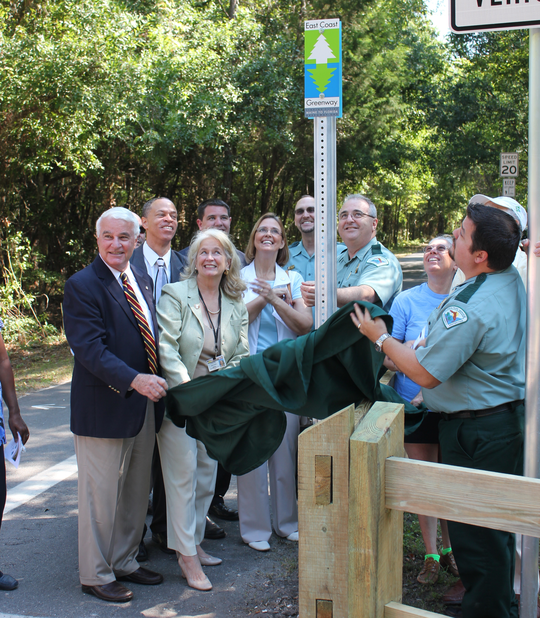FOR IMMEDIATE RELEASE: May 9, 2013
PALATKA-TO-ST. AUGUSTINE TRAIL DESIGNATED AS PART OF EAST COAST GREENWAY
~State trail joins developing 3,000 mile greenway that runs from Maine to Key West~
 Florida Park Service staff and partners unveil the trail sign at the Palatka-to-St. Augustine dedication ceremony.
ARMSTRONG- Today, the Florida Department of Environmental Protection celebrated the Palatka-to-St. Augustine State Trail becoming part of the East Coast Greenway, which stretches 3,000 miles from Maine to Key West.
The Department joined other partners, such as the Florida Department of Transportation, St. Johns County, Putnam County, East Coast Greenway Alliance and the Rails-to-Trails Conservancy in this celebration.
"We are fortunate to live in a state committed to the development of trails," said Florida Park Service Director Donald Forgione. "Trails change the landscape of tourism as they create connections between the state’s natural beauty and the places people choose to live, work and play."
The Palatka-to-St. Augustine State Trail will stretch 19 miles from Palatka to St. Augustine when it is complete. Currently, 8.5 miles are complete. Eleven more miles of trails will be built, with multiple access points. The trail is managed by the cities and counties along the way.The Palatka-to-St. Augustine State Trail is part of the 260-mile St. Johns River-to-Sea Loop that travels through St. Johns, Putnam, Flagler, Volusia and Brevard counties.
The momentum behind the development of the East Coast Greenway and the St. Johns River-to-Sea Loop is continually growing and implements the Priority Network identified by the Florida Greenways and Trails System Plan. The Priority Network is a centerpiece of the Florida Greenways and Trails System Plan.
The benefits of trails include:
- Enhancing the quality of life of residents and visitors.
- Supporting a forward-looking approach to eco-tourism to provide economic benefits.
- Providing opportunities for healthy living.
- Connecting trails to communities and helping develop alternative routes of transportation.
|